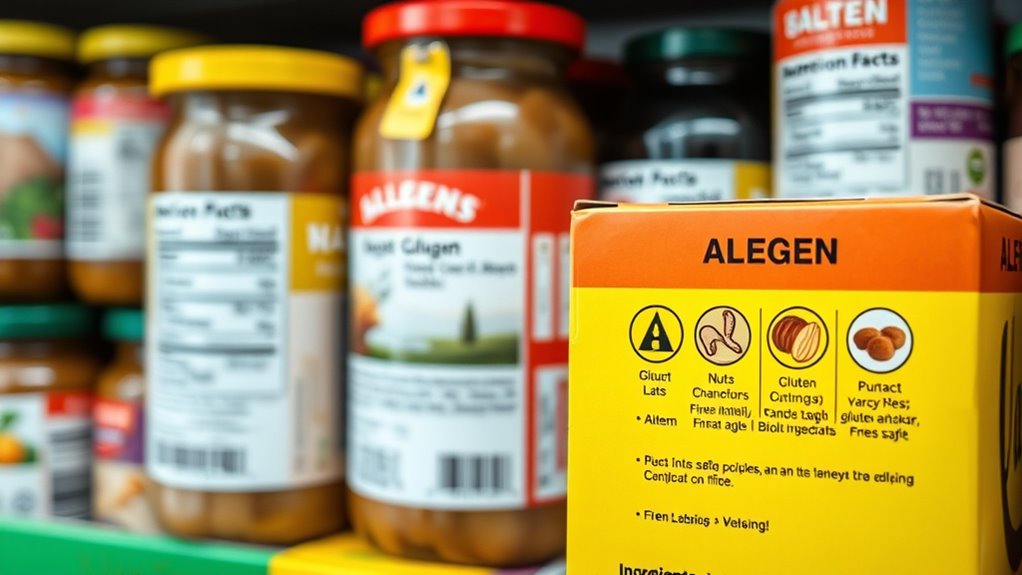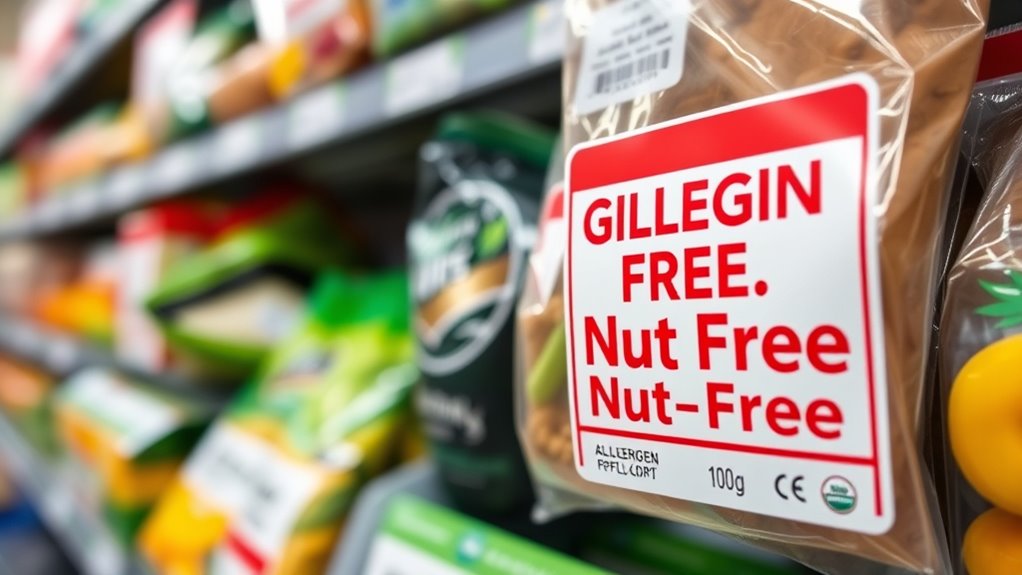Being aware of allergen labeling is essential for your safety, helping you avoid serious health risks like allergic reactions. Clear labels inform you about ingredients and potential cross-contact risks, while strict precautions and verified claims ensure food products are safe. By paying attention to labels and understanding allergy prevention measures, you can make confident, informed choices. If you want to learn more about protecting yourself through accurate labeling and allergen awareness, this guide will help you stay safe and informed.
Key Takeaways
- Accurate labeling helps consumers identify allergen contents and make safe food choices.
- Strict cross contact prevention minimizes unintentional allergen transfer during food preparation.
- Verifying label accuracy through quality controls ensures allergen-free claims are reliable.
- Consumer vigilance, including reading labels and seeking allergen-free options, enhances safety.
- Clear communication from manufacturers and proper labeling practices protect allergic individuals effectively.

Have you ever wondered how allergen awareness and labeling can protect you from unexpected health risks? It’s a vital aspect of food safety that helps you make informed choices and avoid potentially severe reactions. When it comes to allergen safety, understanding cross contact prevention is key. Cross contact occurs when allergenic proteins unintentionally transfer from one food item to another, often through shared utensils, cooking surfaces, or equipment. To reduce this risk, food producers and establishments should implement strict cross contact prevention measures. This means thoroughly cleaning surfaces and utensils, using separate equipment for allergen-free foods, and training staff to recognize and avoid cross contact scenarios. By actively managing these risks, they help guarantee that allergen-free foods stay safe and trustworthy for consumers like you.
Label accuracy verification is another essential component of allergen safety. When you see a label on a product, you rely on its accuracy to determine whether it contains allergens that could trigger your health issues. Manufacturers must verify that their labels are correct, reflecting the true ingredients and potential cross contact risks. Accurate labeling involves rigorous quality control processes, including ingredient testing and thorough review of manufacturing procedures. If a product’s label states it’s free from a certain allergen, you need to be confident that this claim is verified through reliable methods. Mislabeling can have serious consequences, so companies that prioritize label accuracy verification demonstrate their commitment to consumer safety. As a consumer, it’s wise to scrutinize labels closely, especially if you have known allergies. Look for certifications or statements about allergen management and recall histories—these details can give you added confidence that the product has undergone proper verification processes.
In the end, allergen awareness and labeling are about empowering you to protect yourself. By understanding the importance of cross contact prevention, you can better assess how foods are prepared and handled. Meanwhile, paying attention to label accuracy verification helps you trust the information provided. Both practices work together to minimize the risk of accidental allergen exposure, giving you peace of mind during your shopping and dining experiences. Remember, clear communication from manufacturers and diligent food handling are essential for your safety. Don’t hesitate to ask questions or seek out allergen-free options when in doubt. Being proactive and informed makes a real difference in managing your health and staying safe from unexpected allergen risks.
Frequently Asked Questions
How Do I Identify Hidden Allergens in Processed Foods?
To identify hidden allergens in processed foods, you need to scrutinize ingredient lists carefully, looking for any potential allergen sources. Be aware of terms like “may contain” or “processed in a facility that handles” that hint at cross-contamination risks. Always stay vigilant, as allergens can hide in unexpected ingredients, and cross-contamination during manufacturing can introduce allergens even if they’re not listed explicitly.
Are There Global Differences in Allergen Labeling Laws?
Ever wonder if your allergen labels are consistent worldwide? Yes, there are international standards, but legal discrepancies still exist across countries. Some nations require detailed allergen info, while others are more lenient, risking confusion and allergy risks. This inconsistency can make it hard to stay safe when traveling or buying imported products. You need to stay vigilant and understand each country’s specific labeling laws to protect yourself effectively.
What Should I Do if I Suspect a Labeling Error?
If you suspect a labeling error, you should report it promptly using the proper reporting procedures, which often involve contacting the manufacturer or relevant regulatory authority. Your actions support consumer advocacy by helping guarantee food safety and accurate information. Be detailed about your concerns, including product details and where you found the error. This process helps protect others and encourages companies to maintain high labeling standards.
How Can Small Businesses Improve Allergen Transparency?
You can improve allergen transparency by prioritizing customer communication and staff training. Clearly label all ingredients and potential allergens on your products, making information easily accessible. Train your staff to handle allergy inquiries confidently and accurately, ensuring they communicate allergen details effectively. Regularly update your labels and educate your team on new allergens and safety protocols. This proactive approach builds trust and helps protect customers with food allergies.
What Are the Latest Advancements in Allergen Detection Technology?
You should explore the latest advancements in allergen detection technology, like spectral analysis and biosensor development. Spectral analysis enables rapid identification of allergens with high precision, while biosensors provide real-time, on-site testing capabilities. These innovations allow you to quickly detect trace allergens, improve safety, and guarantee compliance. Staying updated with these technologies helps you enhance allergen transparency, protect your customers, and strengthen your business reputation.
Conclusion
Knowing about allergen awareness and labeling is vital for your safety. Did you know that accidental exposure to allergens causes over 200,000 emergency room visits annually? By reading labels carefully and staying informed, you can avoid dangerous reactions and protect yourself and others. Always double-check ingredient lists and ask questions when dining out. Staying vigilant not only keeps you safe but also helps raise awareness for those with allergies. Your attention can make all the difference.









